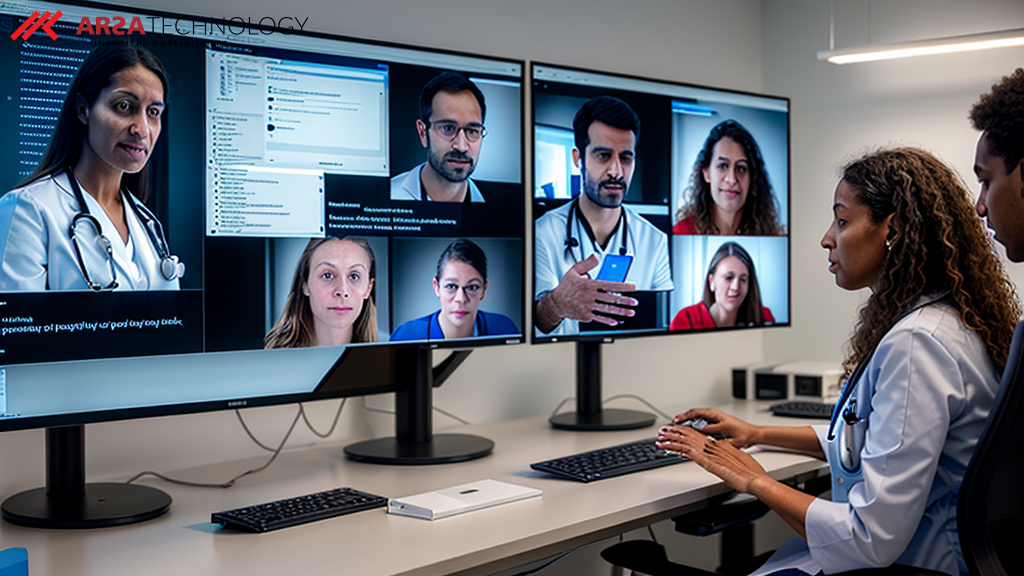Introduction: Overcoming HIPAA Compliance Challenges in the Healthcare Industry
The healthcare industry operates under stringent regulatory frameworks, with the Health Insurance Portability and Accountability Act (HIPAA) standing as a cornerstone for patient data privacy and security. For developers and solutions architects building the next generation of healthcare applications, ensuring robust identity verification is not just a feature—it’s a non-negotiable mandate for protecting sensitive Protected Health Information (PHI). Integrating advanced biometric solutions, such as a Face Recognition API, offers a powerful pathway to secure customer identity verification, yet it comes with its own set of technical and compliance challenges.
This article serves as a comprehensive debugging guide, specifically tailored for those integrating ARSA Technology’s Face Recognition API within healthcare environments. Our aim is to equip you with the knowledge to troubleshoot common integration hurdles, optimize performance, and, crucially, ensure your solutions not only function flawlessly but also uphold the highest standards of HIPAA compliance. By understanding the nuances of API integration and focusing on strategic debugging, you can transform potential compliance roadblocks into opportunities for building trust and delivering superior patient experiences.
The Mandate for Secure Identity: Why Healthcare Needs Robust Biometrics
HIPAA compliance demands rigorous safeguards for electronic PHI, encompassing administrative, physical, and technical measures. Identity verification is at the heart of these technical safeguards, ensuring that only authorized individuals can access patient records, administer care, or manage sensitive data. Traditional methods, such as password-based authentication, are increasingly vulnerable to breaches, phishing, and social engineering attacks, putting patient privacy and organizational integrity at risk.
This is where biometric solutions, particularly facial recognition, emerge as a superior alternative. By leveraging unique biological characteristics, ARSA’s Face Recognition API provides an unparalleled level of assurance in verifying an individual’s identity. This significantly reduces the risk of unauthorized access, strengthens audit trails, and builds a foundation of trust essential for patient engagement and operational efficiency. Our secure identity verification solutions are designed to meet these critical needs, offering a high-performance, reliable tool for the modern healthcare landscape.
Laying the Foundation: Pre-Integration Best Practices for Compliance
Before embarking on the technical integration of any biometric API, particularly in a HIPAA-regulated environment, meticulous planning is paramount. The initial steps often dictate the success and compliance of the entire project.
Firstly, Data Privacy Impact Assessment (DPIA): Conduct a thorough assessment to understand how facial data will be collected, processed, stored, and secured. This includes defining data retention policies and ensuring explicit patient consent mechanisms are in place, aligning with HIPAA’s privacy rule. Transparency with patients about data usage builds trust and fulfills ethical obligations.
Secondly, Secure Data Handling Protocols: Establish end-to-end encryption for all data in transit and at rest. This means ensuring that image data sent to the Face Recognition API is encrypted, and any identifiers returned are handled with the same level of security as other PHI. ARSA’s APIs are built with security in mind, but the responsibility for secure data handling within your application architecture remains critical.
Thirdly, Robust Infrastructure: Ensure your hosting environment and network infrastructure meet the security requirements for handling PHI. This includes firewalls, intrusion detection systems, and regular security audits. A secure foundation is non-negotiable for compliance.
Common Integration Hurdles: Navigating the Path to Seamless Verification
Even with meticulous planning, developers often encounter specific challenges during the integration of a Face Recognition API. Understanding these common hurdles is the first step toward effective debugging and a smooth deployment.
One primary area of concern revolves around Input Data Quality. The accuracy and reliability of facial recognition heavily depend on the quality of the input image. Issues such as poor lighting, low resolution, motion blur, occlusions (e.g., masks, glasses), or extreme head poses can significantly impact the API’s ability to detect and recognize a face accurately. Developers must implement robust client-side validation and user guidance to ensure optimal image capture conditions.
Another common challenge is Network Latency and API Response Handling. In healthcare, timely access to verified identities can be critical. Slow network connections or inefficient handling of API responses can lead to delays, impacting user experience and potentially critical workflows. Optimizing network calls, implementing asynchronous processing, and designing resilient error handling mechanisms are essential.
Finally, Misinterpretation of API Responses can lead to incorrect application behavior. While ARSA’s API provides clear and concise responses, understanding the nuances of success codes, error messages (e.g., “face not detected,” “low quality image,” “no match found”), and confidence scores is crucial for building intelligent and robust application logic.
Strategic Debugging: Ensuring Data Integrity and Performance
Effective debugging goes beyond fixing immediate errors; it involves a strategic approach to ensure the long-term integrity, performance, and compliance of your biometric solution.
Input Data Validation and Pre-processing: Before sending an image to the API, implement client-side checks to ensure it meets basic quality criteria. This might involve checking resolution, file size, and basic image properties. Providing immediate feedback to the user to retake a photo under better conditions can drastically reduce API errors and improve the user experience. For instance, guiding users on proper lighting, head positioning, and avoiding obstructions ensures the API receives the best possible data.
Robust Error Handling and Logging: Design your application to gracefully handle all possible API responses, especially errors. Implement comprehensive logging that captures API request details, response codes, and error messages. This log data is invaluable for diagnosing issues, identifying patterns, and ensuring that your application responds appropriately to various scenarios, such as when a face isn’t detected or a match cannot be confidently made. A well-structured error handling system ensures that even when the API returns an unexpected result, your application maintains stability and security.
Performance Optimization: To minimize latency and ensure a responsive user experience, consider strategies like image compression (without compromising quality), efficient network request management, and caching where appropriate and secure. For high-volume applications, understanding API rate limits and implementing retry mechanisms with exponential backoff can prevent service interruptions. This ensures that the identity verification process is swift and doesn’t impede critical healthcare operations.
Security Considerations in Debugging: During debugging, never compromise on security. Avoid logging sensitive data like raw facial images or direct PHI. Instead, log anonymized identifiers or metadata relevant to the debugging process. Ensure that all debugging tools and environments adhere to the same stringent security protocols as your production environment, maintaining HIPAA compliance throughout the development lifecycle.
Enhancing Security with Liveness Detection: A Layered Approach
While face recognition is powerful for identity verification, it can be vulnerable to spoofing attacks—where an unauthorized individual uses a photo, video, or 3D mask to impersonate a legitimate user. In healthcare, where the stakes are incredibly high due to HIPAA regulations, this vulnerability is unacceptable.
To counter such sophisticated fraud attempts, ARSA Technology offers a vital complementary solution: Face Liveness Detection. This API adds a critical layer of security by verifying that the person presenting their face is a live, present individual, not a static image or a digital reproduction. By detecting subtle movements, reflections, and other biological cues, liveness detection effectively thwarts spoofing.
Integrating liveness detection alongside face recognition creates a robust, multi-layered security framework. This dual-factor biometric approach significantly enhances the integrity of your identity verification process, providing peace of mind that only real, authorized individuals are gaining access. To understand how ARSA helps in preventing fraud with liveness detection, explore our dedicated solutions. For a hands-on experience, you can test the Liveness Detection API and see its capabilities firsthand.
Testing and Validation: Building Confidence in Your Biometric Solution
Thorough testing and validation are indispensable for any API integration, especially when dealing with sensitive data and compliance requirements.
Comprehensive Testing Regimen: Implement a multi-faceted testing strategy that includes unit tests for individual components, integration tests to verify the interaction between your application and the Face Recognition API, and end-to-end tests to simulate real-world user flows. Load testing is also crucial to ensure the system can handle expected user volumes without performance degradation.
Diverse Data Set Validation: Test your integration with a diverse range of facial images, accounting for variations in age, gender, ethnicity, lighting conditions, and common accessories (e.g., glasses, head coverings). This helps identify potential biases or performance discrepancies, ensuring the solution is fair and accurate for all users, which is a key aspect of ethical AI deployment in healthcare.
User Acceptance Testing (UAT) in a Healthcare Context: Involve actual healthcare professionals and patients (under controlled, compliant conditions) in UAT. Their feedback is invaluable for refining the user experience, identifying workflow bottlenecks, and ensuring the solution meets practical operational needs while adhering to privacy expectations.
To see the Face Recognition API in action and conduct your own tests, you can try the Face Recognition API on RapidAPI. This interactive playground allows you to experiment with different inputs and observe API responses, aiding in your development and debugging process.
Beyond Integration: Maintaining Compliance and Optimizing Performance
The journey doesn’t end with successful integration. Maintaining a compliant and high-performing biometric solution requires ongoing effort.
Continuous Monitoring and Maintenance: Implement real-time monitoring of your API integrations to track performance metrics, identify anomalies, and detect potential security threats. Regularly review API logs for unusual activity or persistent error patterns that might indicate underlying issues. Proactive maintenance, including updating API client libraries and staying informed about ARSA Technology’s API enhancements, is crucial.
Staying Updated with Regulatory Changes: HIPAA regulations, along with other data privacy laws, are subject to evolution. Developers and compliance officers must stay abreast of these changes to ensure their integrated solutions remain compliant. This might involve periodic reviews of your data handling policies, consent forms, and security measures.
Iterative Optimization: Leverage performance data and user feedback to continuously refine your integration. This could involve optimizing image capture processes, streamlining API call sequences, or enhancing error recovery mechanisms. The goal is a constantly improving, highly reliable, and compliant identity verification system.
Conclusion: Your Next Step Towards a Solution
Navigating the complexities of HIPAA compliance while integrating advanced technologies like Face Recognition APIs can be challenging. However, by adopting a strategic approach to debugging, focusing on data quality, robust error handling, and layered security, developers can build highly secure and compliant identity verification systems for the healthcare industry. ARSA Technology’s Face Recognition API provides the foundational technology, empowering you to create solutions that protect patient data, streamline operations, and build trust.
Our commitment is to deliver high-performance, reliable AI API products that meet the rigorous demands of global enterprises and developers. By leveraging ARSA’s solutions, you are not just integrating an API; you are adopting a pathway to enhanced security, operational efficiency, and unwavering compliance in the critical healthcare sector.
Ready to Solve Your Challenges with AI?
Discover how ARSA Technology can help you overcome your toughest business challenges. Get in touch with our team for a personalized demo and a free API trial.







